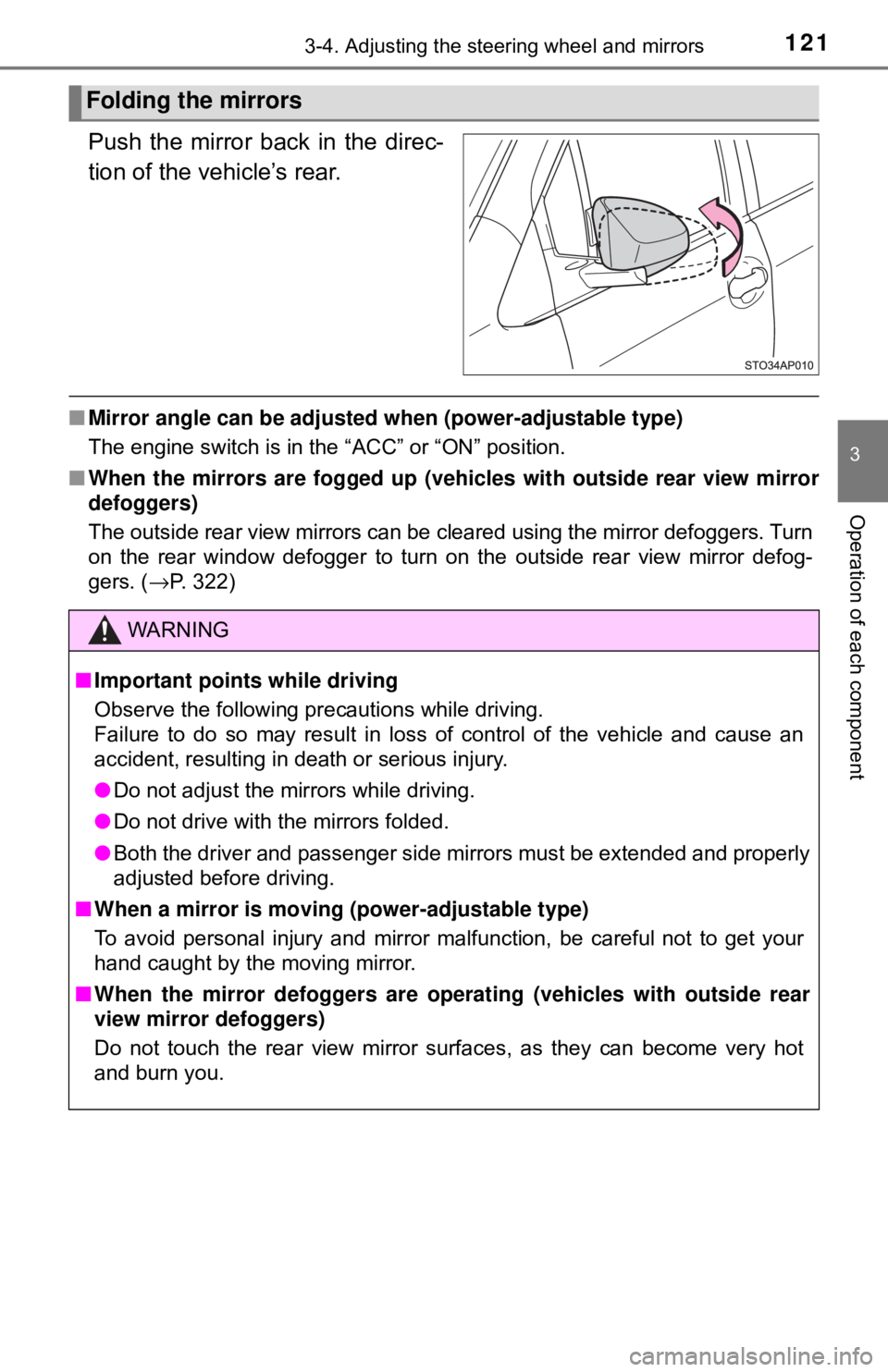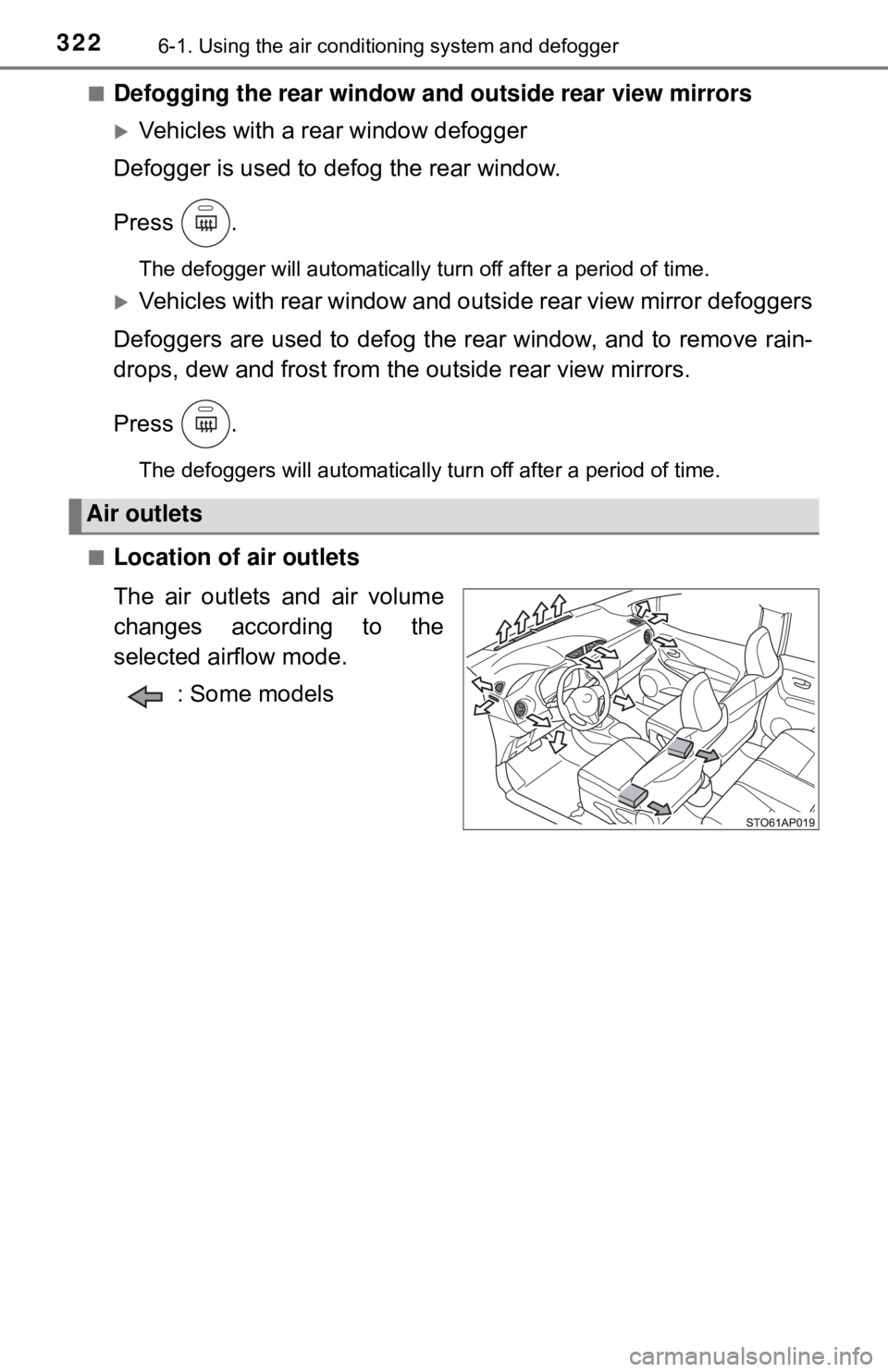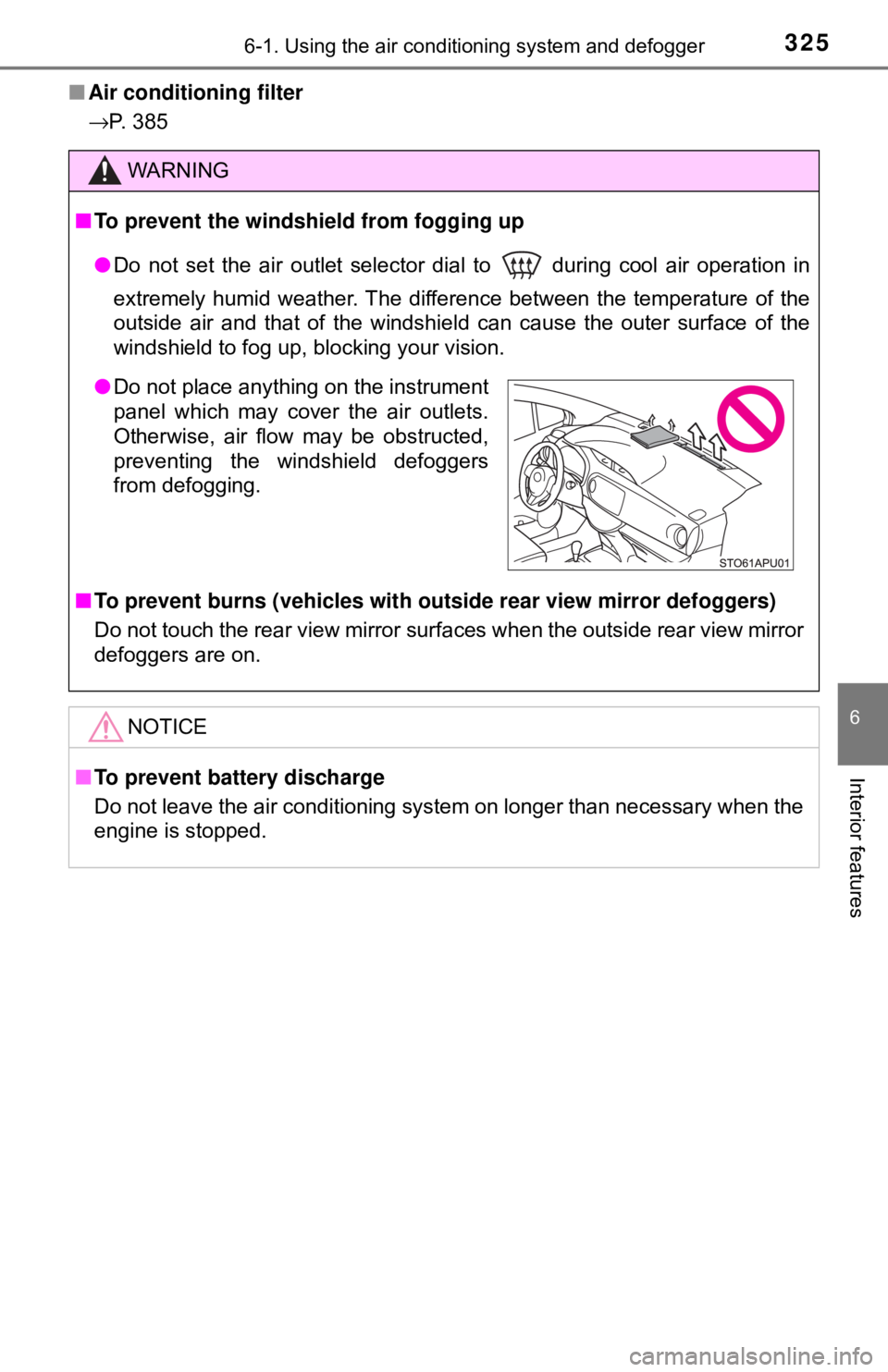2018 TOYOTA YARIS HATCHBACK rear view mirror
[x] Cancel search: rear view mirrorPage 121 of 520

1213-4. Adjusting the steering wheel and mirrors
3
Operation of each component
Push the mirror back in the direc-
tion of the vehicle’s rear.
■Mirror angle can be adjusted when (power-adjustable type)
The engine switch is in the “ACC” or “ON” position.
■ When the mirrors are fogg ed up (vehicles with outside rear view mirror
defoggers)
The outside rear view mirrors can be cleared using the mirror defoggers. Turn
on the rear window defogger to turn on the outside rear view mirror defog-
gers. ( →P. 322)
Folding the mirrors
WARNING
■Important points while driving
Observe the following precautions while driving.
Failure to do so may result in loss of control of the vehicle and cause an
accident, resulting in death or serious injury.
● Do not adjust the mirrors while driving.
● Do not drive with the mirrors folded.
● Both the driver and passenger side mirrors must be extended and properly
adjusted before driving.
■ When a mirror is moving (power-adjustable type)
To avoid personal injury and mirror malfunction, be careful not to get your
hand caught by the moving mirror.
■ When the mirror defoggers are oper ating (vehicles with outside rear
view mirror defoggers)
Do not touch the rear view mirror surfaces, as they can become very hot
and burn you.
Page 131 of 520

1314-1. Before driving
4
Driving
WARNING
Observe the following precautions.
Failure to do so may result in death or serious injury.● Do not drive the vehicle over or stop the vehicle near flammable materials.
The exhaust system and exhaust gases can be extremely hot. These hot
parts may cause a fire if there is any flammable material nearby.
● During normal driving, do not turn off the engine. Turning the engine off
while driving will not cause loss of steering or braking control, but the
power assist to these systems will be lost. This will make it more difficult to
steer and brake, so you should pull over and stop the vehicle as soon as it
is safe to do so.
However, in the event of an emergency, such as if it becomes impossible
to stop the vehicle in the normal way: →P. 413
● Use engine braking (downshift) to maintain a safe speed when driving
down a steep hill.
Using the brakes continuously may cause the brakes to overheat and lose
effectiveness. ( →P. 149, 153)
● Do not adjust the positions of the steering wheel, the seat, or the inside or
outside rear view mirrors while driving.
Doing so may result in a loss of vehicle control.
● Always check that all passengers’ arms, heads or other parts of their body
are not outside the vehicle.
● Do not drive in excess of the speed limit. Even if the legal speed limit per-
mits it, do not drive over 85 mph (140 km/h) unless your vehicle has h\
igh-
speed capability tires. Driving over 85 mph (140 km/h) may result in tire
failure, loss of control and possible injury. Be sure to consult a tire dealer
to determine whether the tires on your vehicle are high-speed capability
tires or not before driving at such speeds.
Page 176 of 520

1764-5. Toyota Safety Sense C
WARNING
●If water droplets cannot be properly removed from the area of the wind-
shield in front of the front sensor by the windshield wipers, replace the
wiper insert or wiper blade.
If the wiper inserts or wiper blades need to be replaced, contact your
Toyota dealer.
● Do not attach window tinting to the windshield.
● Replace the windshield if it is damaged or cracked.
If the windshield needs to be replaced, contact your Toyota dealer.
● Do not install an antenna in front of the sensor.
● Do not get the front sensor wet.
● Do not allow bright lights to shine into the front sensor.
● Do not dirty or damage the front sensor.
When cleaning the inside of the windshield, do not allow glass cleaner to
contact the lens. Also, do not touch the lens.
If the lens is dirty or damaged, contact your Toyota dealer.
● Do not subject the front sensor to a strong impact.
● Do not change the installation position or direction of the front sensor or
remove it.
● Do not disassemble the front sensor.
● Do not install an electronic device or device that emits strong electric
waves near the front sensor.
● Do not modify any components of the vehicle around the front sensor
(inside rear view mirror, sun visors, etc.) or ceiling.
● Do not attach any accessories that may obstruct the front sensor to the
hood, front grille or front bumper. Contact your Toyota dealer for details.
● If a surfboard or other long object is to be mounted on the roof, make sure
that it will not obstruct the front sensor.
● Do not modify the headlights or other lights.
● Do not attach anything to or place anything on the dashboard.
■ Installation area of front sensor on windshield
When the windshield is fogging up easily, the glass around the front sensor
may be hot due to the heater running. If the glass is touched, it may re\
sult in
burns.
Page 214 of 520

2144-6. Using the driving support systems
WARNING
●Do not use the rear view monitor system in the following cases:
• On icy or slick road surfaces, or in snow
• When using tire chains or the compact spare tire
• When the back door is not closed completely
• On roads that are not flat or straight, such as curves or slopes.
● In low temperatures, the screen may darken or the image may become
faint. The image could distort when the vehicle is moving, or you may
become unable to see the image on the screen. Be sure to check direct
visually and with the mirrors all around the vehicle before proceeding.
● If the tire sizes are changed, the position of the fixation guide lines dis-
played on the screen may change.
● The camera uses a special lens. The distances between objects and
pedestrians that appear in the image displayed on the screen will differ
from the actual distances. ( →P. 208)
NOTICE
■How to use the camera
● The rear view monitor system may not operate properly in the following
cases.
• If the back of the vehicle is hit, the position and mounting angle of the
camera may change.
• As the camera has a water proof construction, do not detach, disassem- ble or modify it. This may cause incorrect operation.
• When cleaning the camera lens, flush the camera with a large quantity
of water and wipe it with a soft and wet cloth. Strongly rubbing the cam-
era lens may cause the camera lens to be scratched and unable to
transmit a clear image.
• Do not allow organic solvent, car wax, window cleaner or a glass coat- ing to adhere to the camera. If this happens, wipe it off as soon as pos-
sible.
• If the temperature changes rapidly, such as when hot water is poured on the vehicle in cold weather, the system may not operate normally.
• When washing the vehicle, do not apply intensive bursts of water to the camera or camera area. Doing so may result in the camera malfunc-
tioning.
● Do not expose the camera to strong impact as this could cause a malfunc-
tion. If this happens, have the vehicle inspected by your Toyota dealer as
soon as possible.
Page 322 of 520

3226-1. Using the air conditioning system and defogger
■Defogging the rear window and outside rear view mirrors
Vehicles with a rear window defogger
Defogger is used to defog the rear window.
Press .
The defogger will automatically turn off after a period of time.
Vehicles with rear window and outside rear view mirror defoggers
Defoggers are used to defog the rear window, and to remove rain-
drops, dew and frost from the outside rear view mirrors.
Press .
The defoggers will automatically turn off after a period of time.
■
Location of air outlets
The air outlets and air volume
changes according to the
selected airflow mode. : Some models
Air outlets
Page 325 of 520

3256-1. Using the air conditioning system and defogger
6
Interior features
■Air conditioning filter
→P. 385
WARNING
■To prevent the windshield from fogging up
● Do not set the air outlet selector dial to
during cool air operation in
extremely humid weather. The difference between the temperature of the
outside air and that of the windshield can cause the outer surface of the
windshield to fog up, blocking your vision.
■ To prevent burns (vehicles with outs ide rear view mirror defoggers)
Do not touch the rear view mirror surf aces when the outside rear view mirror
defoggers are on.
NOTICE
■ To prevent battery discharge
Do not leave the air conditioning system on longer than necessary when the
engine is stopped.
● Do not place anything on the instrument
panel which may cover the air outlets.
Otherwise, air flow may be obstructed,
preventing the windshield defoggers
from defogging.
Page 511 of 520

511Alphabetical index
Child-protectors......................... 99
Cleaning ........................... 340, 344Aluminum wheels.................. 341
Exterior ................................. 340
Interior................................... 344
Seat belts .............................. 345
Clock ........................................... 87
Clutch ....................................... 467
Condenser ................................ 365
Coolant ..................................... 364
Capacity ................................ 465
Checking ............................... 364
Preparing and checking before winter....................... 221
Cooling system ........................ 364 Engine overheating ............... 453
CRS (Child Restraint System) .................................... 57
Cruise control .......................... 201
Warning lights ....................... 425
Cup holders.............................. 331
Curtain shield airbags ............... 36
Customizable features ............ 488 Deck board ............................... 335
Defogger
Outside rear view mirrors ..... 322
Rear window ......................... 322
Windshield ............................ 321
Dimensions .............................. 460
Display Drive information .................... 86
Fuel consumption information ........................... 89
Multi-information display ......... 85
Do-it-yourself maintenance .... 353
Door lock Back door ............................. 101
Side doors .............................. 96
Wireless remote control .......... 93
Doors Back door ............................. 101
Door glasses......................... 122
Door lock ................................ 96
Open door warning buzzer ... 425
Open door warning light ....... 425
Outside rear view mirrors ..... 120
Rear door child-protector ........ 99
Side doors .............................. 96
Side windows........................ 122
Driver’s seat belt reminder light ........................................ 425
Driving ...................................... 126 Break-in tips.......................... 129
Correct driving posture ........... 26
Procedures ........................... 126
Winter drive tips .................... 221D
*: For vehicles with Entune Audio Plus,
refer to the “MULTIMEDIA SYSTEM OWNER’S MANUAL”
Page 513 of 520

513Alphabetical index
Flat tire...................................... 433
Floor mats .................................. 24
FluidAutomatic transmission......... 466
Brake .................................... 468
Clutch................................... 467
Washer ................................. 369
Fog lights ................................. 160 Replacing light bulbs............. 401
Switch ................................... 160
Wattage ................................ 470
Front passenger’s seat belt reminder light......... 425
Front seats ............................... 106 Adjustment ............................ 106
Cleaning................................ 344
Correct driving posture ........... 26
Head restraints ..................... 113
Front side marker lights.......... 156
Light switch ........................... 156
Replacing light bulbs............. 401
Wattage ................................ 470
Front turn signal lights ........... 154 Replacing light bulbs............. 400
Turn signal lever ................... 154
Wattage ................................ 470
Fuel Capacity ................................ 464
Fuel gauge .............................. 83
Fuel pump shut off system.... 421
Information ............................ 471
Refueling............................... 168
Type ...................................... 464
Warning light ......................... 425
Fuel consumption information .............................. 89 Fuel consumption
Average fuel consumption ...... 86
Instantaneous fuel consumption ......................... 86
Fuel filler door ......................... 168 Refueling .............................. 168
Fuel pump shut off system..... 421
Fuses ........................................ 391
Gas station information .......... 520
Gauges ....................................... 83
Glove box ................................. 331
Hazard lights
Switch ................................... 412
Head restraints ........................ 113
Headlights ................................ 156 Automatic High Beam ........... 196
Light switch ........................... 156
Replacing light bulbs ............ 397
Wattage ................................ 470
Heaters ..................................... 318 Manual air conditioning
system .......... ...................... 318
Outside rear view mirrors ..... 322
Seat heaters ......................... 326
High mounted stoplight Replacing light bulbs ............ 409
Hood ......................................... 356
Open ..................................... 356
Hooks Retaining hooks (floor mat) .... 24
Horn .......................................... 116
F
G
H